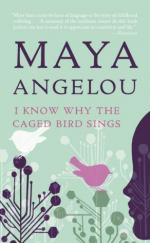|
This section contains 647 words (approx. 2 pages at 400 words per page) |

|
I Know Why the Caged Bird Sings Summary & Study Guide Description
I Know Why the Caged Bird Sings Summary & Study Guide includes comprehensive information and analysis to help you understand the book. This study guide contains the following sections:
This detailed literature summary also contains Quotes and a Free Quiz on I Know Why the Caged Bird Sings by Maya Angelou.
I Know Why the Caged Bird Sings is Maya Angelo's painful, yet inspiring, autobiography about her childhood as a black girl in the deep South. Maya is sent to Stamps, Arkansas, by her parents from Long Beach, California. Her parents do not have time for Maya and her brother Bailey. Maya is not accustomed to the discrimination of the South, but she soon learns about the deep differences between blacks and whites. However, her grandmother is one of the few store owners in town, and the only colored store owner. As a result, she is not only well respected by the blacks of the small community, but she is marginally respected by the whites. Therefore, Maya's experiences are different from many, even during the deepest part of the Depression.
This changes, however, when her father returns for Maya and her brother, taking them to live in St. Louis with their mother. Beautiful and part of a powerful family, their mother is the daughter of Grandmother Baxter, a powerful nearly-white woman. The family has power over police as well as other local crime families, and Maya admits she loves the dangerous life. However, it is in this life that Maya, at age eight, is raped by her mother's boyfriend. When the family discovers her secret, they kill the man after he is released from jail. Maya stops speaking to anyone but Bailey, and the two are shipped back to Stamps once again. Maya continues to develop and to experience the low level discrimination common in the South, from dentists who won't treat her because of her skin color to daily struggles with whites. After Bailey is harassed by white police, the children are shipped back to their parents who are in California.
It is during World War II and their mother's marriage to a powerful businessman that Maya learns about the Black underground. But, she also learns about love and respect, as her new step-father is a kind and caring man. Then, she is sent to live with her father for a summer, and she again learns how selfish people can be. Her father finds escape from his girlfriend in a Mexican bar with prostitutes, dragging his young daughter with him. Too drunk to drive, Maya is forced to attempt to take him home. She crashes the car at the Mexican border. Returning home, Maya is cut open by her father's girlfriend and sent to stay with friends. After running away, she finds herself in a junkyard community with other homeless youths. It is here she learns tolerance, brotherhood, and community. After a month, she returns to her mother and discovers that her time away has made her life far less exciting. Bailey soon leaves the house to take a position with the railroad, and Maya finds herself heavily discriminated against when trying to find work. She fights against the city rail system. Eventually, she becomes the first black employee of the San Francisco street car system.
Over the next year, Maya realizes she is still fighting against the "normal" life of those around her, as her experiences have aged her considerably beyond her peers. She finds herself confused by her maturation into womanhood. Maya takes a local lover as her first encounter, only to find herself pregnant. Maya pushes forward, completing her high school education and giving birth only two weeks later. Maya is terrified once her child is born, but her own mother teaches her that being a mother is instinctual and that she can only succeed.
"I Know Why the Caged Bird Sings" is an insightful look into the life of a beloved poet who draws strength, encouragement, and love from her exciting childhood. Although certainly disadvantaged and troubled, Maya uses her childhood to push herself forward. Her life is proof that with faith, love, and acceptance, one can overcome anything.
Read more from the Study Guide
|
This section contains 647 words (approx. 2 pages at 400 words per page) |

|



